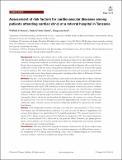| dc.description.abstract | Background: Mortality and morbidity due to cardiovascular diseases (CVDs) are escalating worldwide,
with disproportionately significant worse outcomes in developing countries, due to rapid health and nutrition
transition resulting from unplanned urbanization, negative effects of globalization and sedentary lifestyles.
Despite the growing trends of CVDs cases in hospital settings especially in Tanzania, still no study has been
conducted to evaluate CVD risk factors among patients attending cardiac clinics, to see how they respond
to current treatment. This study aimed at assessing lifestyle risk factors and biomarkers associated with
hypertension and coronary heart diseases among patients attending cardiac clinics at Kilimanjaro Christian
Medical Centre referral hospital in Tanzania.
Methods: This was a cross-sectional hospital-based study conducted to determine the prevalence of lifestyle
and intermediate risk factors for hypertension and coronary heart disease among patients with hypertension
and coronary heart diseases who attended the cardiac clinic at Kilimanjaro Christian Medical Centre referral
hospital between April to July 2008. Information on socio-demographic characteristics, medical condition
and lifestyle risk factors for hypertension and coronary heart diseases were collected using a structured
questionnaire. Blood samples were collected from each patient and analyzed by Cobas Integra and Maglumi
analyzers, to detect and quantify important biomarkers. Descriptive statistics were used to analyze sociodemographic, lifestyle risk factors and biomarkers for hypertension and coronary heart diseases. Pearson’s
chi-square (χ
2
) tests were used to associate risk factors for hypertension and coronary heart diseases, and
multinomial logistic regression was used to determine independent predictors for hypertension and coronary
heart diseases.
Results: Of the 100 patients recruited to participate in the study, 65% had hypertension, 23% had coronary
heart diseases and 12% had both disease conditions. The most prevalent risk factors for hypertension and
coronary heart diseases were: alcohol intake (67%), high blood pressure (59%), physical inactivity (61%),
obesity (39%), alanine aminotransferase (43%), high-density lipoprotein (79%), low-density lipoprotein
(65%), C-reactive protein (78%), sodium (41%) and potassium (40%). Moreover, age, plasma glucose,
alanine aminotransferase, and C-reactive protein were found to be independently and positively associated
with hypertension and coronary heart diseases.
Conclusions: This study affirmed the exposure of patients to cardiovascular risk factors, despite being
under medical management. These findings call for sensitization programs and additional interventions in
the management of CVDs among patients attending cardiac clinics in Tanzania hospitals, to include health
education on lifestyle risk factors modification and proper dietary habits. | en_US |

